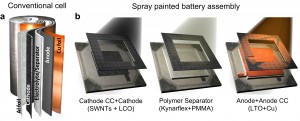Spray-on battery, 3D printing
 Rice University demos a process to spray-on batteries. This is Another step towards fully automated fabrication.
Rice University demos a process to spray-on batteries. This is Another step towards fully automated fabrication.
It was easy to predict that 3D printing would be able to make electronic parts. The process Rice uses probably doesn’t actually need 3D printing to work but it fits the concept. Multiple layers of different materials are sprayed on a surface to create a battery.
Circuits are already being made using normal 2D printers by varying the thickness of the traces to create resistors and conductors. By using a 2 or 3 different materials the full range of electronic parts could be printed directly into the circuit so a robot could literally print a copy of itself. Stratasys and Optomec have already printed electronics.
The spray-on battery will make it easier to build batteries of different shapes and sizes. It will also make it possible for nearly anyone to make batteries anywhere in the world. This can drastically reduce the real costs in terms of time and materials.
3D modelling as easy as playing with dolls
This simple device will change the world! It’s an essential step to breaking down the barrier to robotics, 3D printing, and 3D media.
This action figure allows anyone with a computer and free software to create 3D animations. Move the arm of the doll and the arm on the screen moves the same way. This is the most intuitive way to work.
Powerful low cost computers and free software have enabled anyone to produce media as good or better than professionals. Even though the basic tool are available to anyone, 3D modeling has remained too difficult for most people because it required specialized skills to draw the models. A literal hand-on user interface bring 3D modeling to anyone.
The difficulty of 3D modeling isn’t just a problem for media it limits the progress of 3D fabricating like 3D printing and CNC. If you can literally move objects you can focus on the results instead of how to communicate with the computer.
Using a computer allows you to do many things you can’t just by hand. You can work on objects much smaller or larger than you could in real life. You can record the movements then edit those movements later or make small adjustments . After recording the movements you can play them back or direct robot / printer / CNC machine to perform the task. And the machine can do it much faster or slower than you can manually do. This opens up vast possibilities.
Simple intuitive user interfaces combined with exiting robotics will change the world.



 Predictive Innovation Training
Predictive Innovation Training Predictive Innovation: Core Skills Book
Predictive Innovation: Core Skills Book RoundSquareTriangle.com
RoundSquareTriangle.com